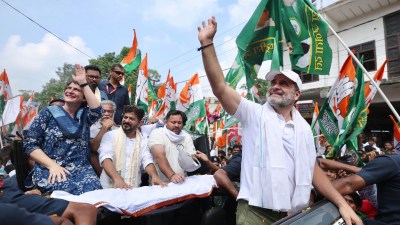Murbad tribals thrust back into the primitive age
May 12: Darkya Padir has been around for almost forever. He is in his late 90s. But his most recent memories are steeped in the pain of d...

May 12: Darkya Padir has been around for almost forever. He is in his late 90s. But his most recent memories are steeped in the pain of displacement that he shares with 1,500 other Katkaris. For these tribals, from six hamlets in Murbad taluka in Thane district, time was when they tilled 204 hectares in Patgaon and Malegaon and sold the produce for a handsome profit, by their standards at least. Now they pluck the forest’s produce and subsist solely on its bounty.
The backflip in time was, ironically, tirggered only about six months ago, by the forces of `development’ and caprice that have crept in from nearby Mumbai city.
Since October 1998, about 1,500 Katkari tribals have been pushed back into the surrounding, denuded, forest from where they descended centuries ago. Today, their property is being sold by the central government to wealthy persons from Mumbai, who are snapping it up at around Rs 40,000 per acre.
Adivasi rights activist Vijay Sathe of the Shramik Mukti Sanghatana, explains that the landthe Katkaris have been tilling was declared as evacuee property under the Rehabilitation Act, 1948, ever since the Muslim owners left for Pakistan following Partition. He says the act empowers the central government, which entrusted it to the local collector as custodian, to allot such land to refugees entering this country only, though the authorities have already sold about 150 hectares to private parties.
Besides, Sathe says, under the Tenancy Act, 1957, any person who has tilled land for over 20 years cannot be dispossesed, which means the government can at no cost take a suo moto decision to sell the property. Moreover, he adds, under the Atrocities Act, agricultural land belonging to adivasis can neither be bought nor sold.
Darkya Padir remambers how his landlord, Abdul Razak, who resided at Badlapur, would regularly send his henchmen to collect the rent which was paid in kind “whether the crop was good or not”. He also says the adivasis have preserved receipts of the cess they have been paying tothe tehsildar since then, the only tangible link they have with their property located in the hamlets of Padhirwadi, Chafyachiwadi, Kamalwadi, Getachiwadi, Waghyachiwadi and Patgaon. This, he explains, made them the rightful owners of the land ever since the original owners left for Pakistan.
Sathe points out: “Since the title deeds are now passed on to the new owners directly at the tehsildar level, the adivasis have been kept totally in the dark.” Today, 150 hectars stand in the names of 32 private parties, who have bought 117.73 of the 129 hectares of evacuee property in Patgaon and 45.96 of the 74.87 hectares in Malegaon, according to records in the tehsildar’s office.
“First the Mumbaikars fence off the land, then they build houses and employ security guards who prevent us from even picking up the dung our cattle leave behind,” says Pandu Hari Poonjara (70) of Waghyachiwadi.
“For Mumbaikars, the land is plum property due to its proximity to the city. Since there is no one to question theauthorities, they simply transfer it to non-agricultural land in the record books and after this they sell it at astronomical rates, Sathe explains.
Murbad tehsildar Jalsingh Valvi told Express Newsline that the adivasis should have approached the central government when the Tenancy Act came into being in 1957! “Why have they begun opposing the sale of land to outsiders now,” he asks, alleging that the tribals are being instigated. Counters Tukaram Bhiva Padhir (60) of Padhirwadi: “The tehsildar cuts deals in his office. We do not have access to such goings-on.”
However, Konkan Division Revenue Commissioner Sharwari Gokhale, says: “As far as the state of Maharashtra is concerned, the tehsildar is merely the custodian of the evacuee land which is Centre’s property. There has been no move to sell any land. The status quo has been maintained since Independence."



- 01
- 02
- 03
- 04
- 05




























